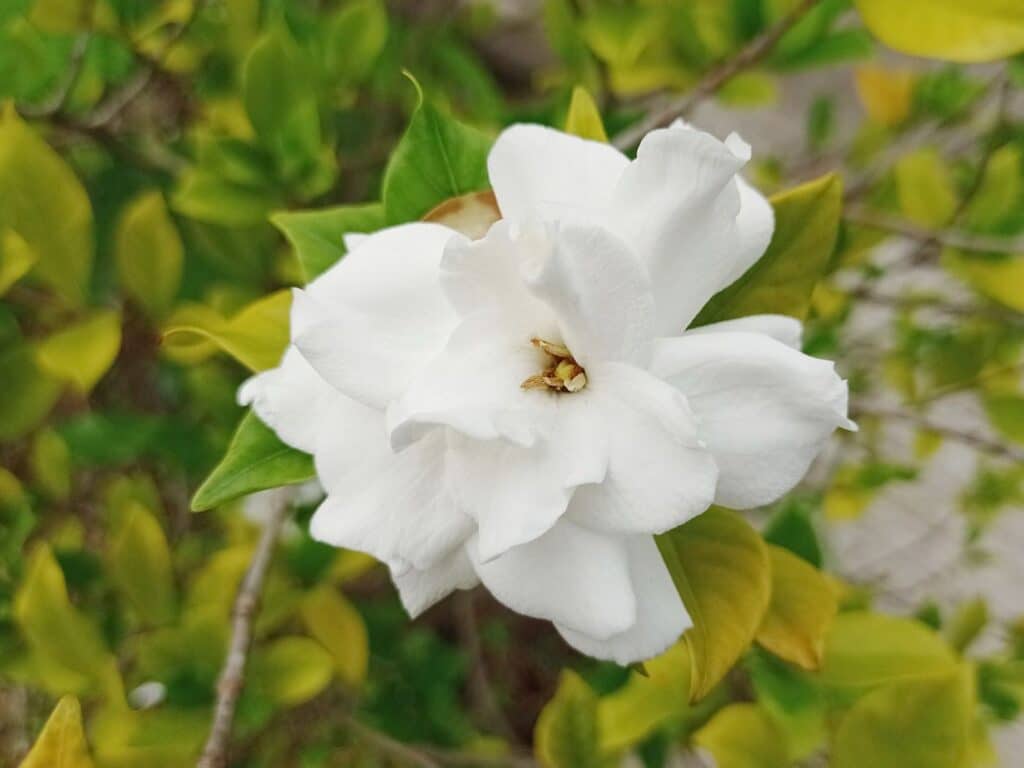Gardenias, with their intoxicating fragrance and lush, dark green leaves, are the crowning jewels of many gardens. Yet, the sight of yellow leaves can quickly turn your gardening success into worry.
If you’ve noticed a change in the vibrant green foliage of your gardenias, it’s a sign that your plant may be under stress. Understanding the delicate balance of conditions these plants thrive in is crucial, as they are surprisingly intolerant of changes in water, nutrients, light, and soil.
The yellowing of gardenia leaves can be a natural process or an alarm bell, signaling that your plant’s health may be compromised. As we delve into the possible reasons behind this discoloration, remember that the solution often lies in addressing the root cause.
Whether it’s adjusting the care routine or modifying the environment, there’s hope for restoring your gardenias to their former glory. Let’s explore how you can identify and rectify the issues leading to yellow leaves, ensuring your gardenias remain a vibrant and healthy part of your garden.
Understanding the Problem: Why Gardenia Leaves Turn Yellow
Identifying Common Culprits Behind Yellowing Leaves
The transition of gardenia leaves to a yellow hue often signals distress, but pinpointing the exact cause requires a bit of detective work. If you notice the vibrant green start to fade as winter melts into spring, cold stress may well be the villain.
However, the plot thickens as the seasons warm up. A shortage of iron or magnesium frequently steps into the spotlight. Magnesium scarcity typically targets the older leaves, leading to their downfall. A sprinkle of Epsom salts around the base of your plant can be a game-changer here.
On the flip side, iron deficiency prefers to wreak havoc on new growth. Addressing this involves applying iron chelates during late spring and once again in the summer for best results. Each leaf tells a story, and understanding these signs can steer you back on course to lush, green foliage.
The Role of Climate in Gardenia Health
Climate plays a leading role in the wellbeing of your gardenias, influencing everything from leaf color to flower production. Gardenias revel in warmth and consistency, throwing a bit of a tantrum with too much cold or abrupt changes in temperature.
Winter leaf drop is a common scene in cooler climates, a natural process as the plant adjusts to less than ideal conditions. However, it’s crucial to remember that some leaf drop is a seasonal script for gardenias, especially as they gear up for new growth in warmer weather.
The key takeaway? Providing a stable, warm environment keeps your gardenias happy and reduces the chances of those yellow alerts. Short, sweet, and to the point, your gardenias will thrive with a bit of understanding, timely care, and a watchful eye on their climate needs.
Causes of Yellowing Gardenia Leaves

Nutrient Deficiencies and Soil Imbalances
Yellow leaves on your gardenia may well scream “Feed me!” or “Help me!” due to nutrient deficiencies. Gardenias are quite the divas, demanding specific nutrients, like iron and magnesium, to maintain their lush, green appearance.
If these are missing from the soil, your plant may well throw a fit, showcasing yellow leaves as a sign of protest. Additionally, soil that’s not up to par can contribute to the issue, straining the plant’s ability to uptake necessary nutrients effectively.
Watering Issues: Overwatering and Underwatering
Striking the right balance with watering is like walking a tightrope. Too much water, and you risk drowning the roots, leading to yellow leaves from a lack of oxygen.
Too little, and you’ll find the outer leaves turning yellow and crispy as a desperate call for hydration. Remember, the goal is to keep the soil moist, not soggy or bone dry. It’s a sort of Goldilocks scenario where only “just right” will do.
The Effects of Incorrect Soil pH on Gardenias
Gardenias prefer their world slightly acidic, thriving in soil pH levels between 5.0 and 6.5. When the pH skews too high, gardenias struggle to absorb nutrients like iron and magnesium, vital for keeping their leaves a vibrant green.
It’s akin to having a feast in front of you but no way to eat it. A simple soil test can tell you if your gardenia is living on the wrong side of the pH scale, starving amidst plenty.
Diseases That Cause Yellowing Leaves
Lastly, diseases can turn your gardenia leaves yellow, but this is more like the plant sending out an SOS. Fungal issues such as root rot or pests attacking the roots cause stress, manifesting in those telltale yellow leaves. It’s the plant’s way of saying, “I’m in trouble here!” Diagnosing the disease early can save your gardenia from turning into a yellow-leafed spectacle.
Preventative Measures to Keep Gardenia Leaves Green

Appropriate Watering Techniques for Gardenias
Getting your watering game right with gardenias is like threading a needle while riding a bike — challenging but crucial. These plants demand consistency, neither too thirsty nor drowning. Aim for moist, but not soggy soil. Think of it as giving your plant a steady sip, not a gulp.
Using a pot with drainage holes can save you from the quagmire of overwatering. Checking the top two inches of soil for dryness before watering guides you on when to water next. This simple trick ensures your gardenia gets just the right amount of hydration, keeping those leaves vibrant and green.
Soil Maintenance for Healthy Gardenias
Soil is more than just dirt to your gardenias; it’s their home, pantry, and comfort zone all rolled into one. Striking the right balance in soil composition paves the way for lush, green leaves. A pH range of 5.0 to 6.5 hits the sweet spot, allowing gardenias to absorb nutrients effectively.
Consider integrating organic matter like compost or peat moss to improve drainage and retain the right moisture level. Also, a routine check-up of the soil’s pH level keeps you ahead, preventing nutrient lockout. Remember, a happy gardenia roots in happy soil.
Corrective Actions for Yellowing Gardenia Leaves
Adjusting Watering Habits
A bit like a diva, your gardenia demands the perfect amount of water – not too much, not too little. Overwatering leads to root problems, and underwatering will stress it out. Check the soil’s moisture by feeling it a few inches deep; if it’s dry, it’s time for a drink. Aim for consistency; setting reminders can help keep your gardenia’s thirst quenched just right.
Balancing Soil pH for Gardenias
Gardenias flaunt their best green when the soil acidity hits that sweet spot between 5.0 to 6.5 pH. Too alkaline or too acidic, and they throw a fit with yellow leaves. Grab a soil test kit from your local gardening store. If you’re off the mark, adding sulfur decreases pH, while lime increases it. This minor adjustment can lead to major improvements in leaf health.
Addressing Nutrient Deficiencies
Yellow leaves could be your gardenia’s cry for help, signaling it’s missing some vital nutrients. Iron and magnesium are often the culprits. Before you start adding anything, test the soil to see what’s lacking.
If iron is the issue, a chelated iron supplement can green things up. For magnesium, a dose of Epsom salts mixed with water does wonders. Remember, the goal is to act as a plant nutritionist, providing exactly what’s missing, no more, no less.
Seasonal Care Tips to Prevent Yellow Leaves
Prepping Gardenias for Colder Weather
Preparing your gardenias for the colder months involves a bit more than just talking to them nicely, although that doesn’t hurt. First off, gradually reduce watering as the temperature drops; your gardenia doesn’t drink as much when it’s chilly.
Also, consider applying a layer of mulch around the base to keep the roots cozy. This simple step can significantly reduce stress on your plant, helping it retain its vibrant green leaves.
Managing Gardenias During Peak Sun Exposure
When the sun is out in full force, your gardenias may well feel like they’re in a desert rather than your loving garden. To combat this, ensure your plants receive morning sunlight but are shielded during the harsher afternoon rays.
A little shade can go a long way in preventing those leaves from turning yellow. Additionally, maintaining consistent soil moisture is key. Not too much, though—no gardenia enjoys soggy feet. A well-draining soil setup can be your best ally against the struggles of high sun exposure.
Frequently Asked Questions
How often should gardenias be watered?
Gardenias should receive at least one inch of water weekly through rainfall or manual watering. It’s crucial to keep the soil consistently moist but not waterlogged. Applying 2-4 inches of mulch can help retain soil moisture and reduce watering frequency.
What fertilizer is good for yellow leaves on gardenias?
To combat yellow leaves, gardenias benefit from monthly fertilization from late spring through summer. Opt for a balanced flower and fruit fertilizer, or a seaweed tonic, and ensure the plants are shielded from harsh sun exposure.
How to rejuvenate a gardenia?
Revitalizing a gardenia involves providing plenty of bright, indirect light, especially in the morning. If the plant appears leggy or overgrown, consider pruning or pinching it back to promote healthy new growth. This, combined with proper care, can rejuvenate gardenias effectively.
What helps gardenias grow?
Gardenias thrive in acidic soil with a pH of 5.0 to 6.0. The soil should be rich, moist, and well-draining. Enhancing soil fertility with aged manure or compost before planting can provide an optimal growing environment for gardenias.
How do I add Epsom salt to my gardenia?
Incorporate Epsom salt into your gardenia care routine by dissolving two tablespoons of Epsom salt per gallon of water. Use this solution for watering once a month to help improve bloom health and support overall plant vitality.
Up next: Top 5 Gardenia Companion Plants and Good Landscaping Tips







